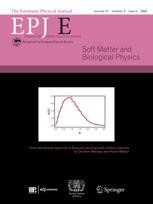Improving fluid simulations with embedded neural networks
While neural networks can help to improve the accuracy of fluid flow simulations, new research shows how their accuracy is limited unless the right approach is taken. By embedding fluid properties into neural networks, simulation accuracy can improve by orders of magnitude.
New York | Heidelberg, 8 Mai 2023
 The Lattice Boltzmann Method (LBM) is a simulation technique used to describe the dynamics of fluids. Recently, there has been an increasing interest in employing neural networks for computational modelling of fluids. The results of a collaboration between researchers from Eindhoven University of Technology and Los Alamos National Laboratory, published in EPJ E, show how neural networks can be embedded into a LBM framework to model collisions between fluid particles. The team found that it is essential to embed the correct physical properties into the neural network architecture to preserve accuracy. These discoveries could deepen researchers’ understanding of how to model fluid flows.
The Lattice Boltzmann Method (LBM) is a simulation technique used to describe the dynamics of fluids. Recently, there has been an increasing interest in employing neural networks for computational modelling of fluids. The results of a collaboration between researchers from Eindhoven University of Technology and Los Alamos National Laboratory, published in EPJ E, show how neural networks can be embedded into a LBM framework to model collisions between fluid particles. The team found that it is essential to embed the correct physical properties into the neural network architecture to preserve accuracy. These discoveries could deepen researchers’ understanding of how to model fluid flows.
The LBM works by dividing flows into grids of tiny cells: tracking the movement of particles between cells, then calculating how the distribution of particles in each cell changes over time. One of the LBM’s key requirements is to model collisions between particles. Several different models are now capable of doing this, and by appropriately recreating these collisions within the LBM, researchers can now use them to model a diverse array of flow systems.
In their study, the Eindhoven and Los Alamos teams assessed the reliability of this approach by using the LBM to model time-varying behaviour in a variety of complex flows. They discovered that ‘vanilla’ neural network architectures, with no enforcement of physical properties, have a very limited accuracy when calculating particle collisions. Yet by embedding the unique physical properties of real flows – including conservation laws and spatial symmetries – their accuracy in reproducing time-varying dynamics can improve by some 4 orders of magnitude. The authors hope their discoveries could have important implications for fluid dynamics: allowing researchers to simulate systems including mixtures of gases, turbulent flows, as well as more exotic quantum fluids.
References: Corbetta, A., Gabbana, A., Gyrya, V. et al. Toward learning Lattice Boltzmann collision operators. Eur. Phys. J. E 46, 10 (2023). https://doi.org/10.1140/epje/s10189-023-00267-w
Further Information
For more information visit: www.epj.org
Services for Journalists
The full-text article is available here.
Contact
Sabine Lehr | Springer | Physics Editorial Department
tel +49-6221-487-8336 | sabine.lehr@springer.com
